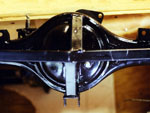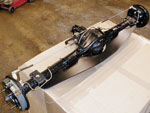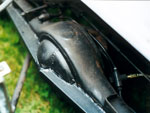
Cars - History - Legend - Stories - For Sale
|
Thanks to those who supplied photos. If you would like your car to be identified with your axle, just let me know. AND, if you have some other type or bracing or reinforcement of the axle, please send a photo and description to [email protected] To set the stage, read over the Technical Bulletin written by David Kaplan of DSK Cars several years ago. In the bulletin he analyzes the unusual stresses to which the T10 axle is subjected in its application to the Lotus Seven. See also his current thoughts further down this page. |
|
'SQUARE TUBE' BRACING 'STEGOSAURUS PLATE' BRACING VARIATION ON SQUARE TUBE VARIATION ON STEGOSAURUS PLATE–PLUS SQUARE TUBE BRACING DSK Variation David Kaplan provided a further analysis more recently (January 2007) after reviewing the solutions put forth on this page: "The bulletin you reference [top of page] appears to be an older one about the beleaguered T10 axle in Sevens. As I recall, the later ones included drawings to illustrate the unusual application of twisting forces (torque) to the T10 housing in a stock Seven. Fortunately, Dennis Ortenburger reproduced that drawing on page 40 of "Legend of the Lotus Seven." (Page 151 also presents the dsk cars proprietary rear suspension, though the load paths are less well illustrated. The arrow in the latter drawing might better be shown to go around the axle housing from the upper to the lower trailing arm pick-up points - a mercifully short path that does not apply torque over the length of the axle tube, but instead loads only a small and well-reinforced (by stout bracket) section of the tube.) These drawings and their accompanying text help explain the suspension design problem; one that applies loads that distort the housing sufficiently to mis-align the internal mechanicals and contribute to leaks, axle breakage and accelerated component wear. The housing was not manufactured with such loads in mind. Bracing the axle housing is a crude fix no matter how accomplished, because it addresses the symptoms but not the underlying cause. Long longitudinal braces do not resist twisting very well, and so Lotus employed huge, heavy and uniquely un-Lotus-like steel plate braces. On a car with so many elegant-if-frail design choices, this klutzy brace stands out as a brute-force, quick-fix unworthy of the Seven or Lotus. It long remained an un-addressed design flaw. Any solution that attempts to brace the axle housing fights an uphill battle. Long components simply do not resist torque loads efficiently. The big flat plate is perhaps the worst imaginable solution because it (1) adds a great dead weight to a car whose forte is a lightweight design, (2) adds that weight to the unsprung mass of the rear axle, and (3) thus needlessly reduces the sprung to unsprung weight ratio in a live axle car where that ratio can matter a great deal. An experienced test driver will notice the resulting excessive rear axle hop when encountering road surface irregularities during hard cornering. The worst case situation occurs when the road gets rough under hard breaking or acceleration while turning. Bracing the rear axle in a more elegant manner, using welded tubing instead of flat plate moves in the right direction at least on the unsprung weight dimension of the problem. Of course, the decided inelegance remains of trying to stiffen against a torque load with a long reinforcing member. Such "braces" do not themselves efficiently resist torque-induced distortion. Hence, they must generally be big, cobbled compromises to have any real effect at all. Replacing the heavy stock plate with 1x2 tubing welded along the axle tubes certainly looks much lighter and more efficient, but how well does it actually resist torque? One relatively simple test is to clamp one end of a 1x2 of the appropriate length into a stable, well-mounted vice and attach a lever firmly to the end of the tube. Then suspend known weights from the lever and measure how much torque (in foot-pounds) it takes to begin twisting the tube. Use a dial indicator set on the tubing near the lever to detect when the tube starts to twist. Perhaps some list member will undertake to conduct a complete experiment by testing an original axle housing with the flat brace, another with no brace and others with various alternative tubular braces. Short of finite element analysis, such a simple test, carefully executed, offers the most accurate and reliable answers to your question. Note however that the build-a-better-brace approach can provide little more than a somewhat less quick-and-dirty fix for the original quick-and-dirty fix. The problem is not that lightweight sports racers need well-reinforced axle housings. The keys to success in employing a live axle are to (1) locate it properly throughout its dynamic range, and (2) keep the sprung-to-unsprung weight ratio as high as possible. Reinforcing braces do nothing for the former and less than the maximum possible for the latter. At dsk cars, we chose to modify the rear suspension and replace the lower A-frame with properly articulated trailing arms and Panhard rod. That is a correct engineering solution, although it obviously conflicts with the goal of maintaining originality that many will prefer, but then so do brace modifications. The dsk cars fix has the obvious drawback of design and implementation complexity. Perhaps that helps explain why Lotus retained the original heavy-handed and inadequate flat brace for so long. On the plus side, a properly located rear axle really delivers in performance. I recall when Csaba Csere first scared the hell out of me during his test drive of our TurboSeven prototype on a twisty canyon road. He got out and peered under the car at the first stop to assure himself that it was really a live axle suspension. He shook his head in disbelief as he told me how much it surprised him that a live axle car could handle that well." |
Cars - History - Legend - Stories - Sale
![]()










